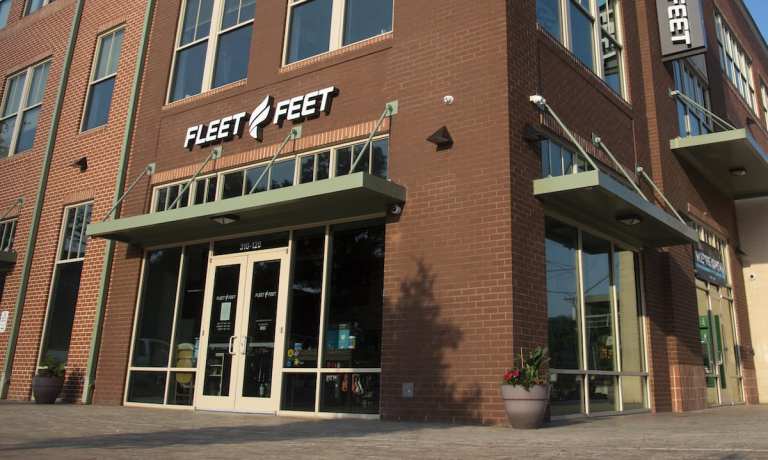
Americans are exercising through the pandemic. Just ask Nike or Peloton, who have racked up impressive usage and revenue KPIs over the past few months. And not all of the action is taking place in front of a screen, or even indoors. Specifically, Americans are running through the pandemic.
According to the NPD Group, COVID-19 brought the year’s good start to a halt, with March athletic shoe sales down about 40 percent compared to 2019 and taking a 50 percent hit in April. But June bounced back up by about 25 percent, and all indications are that the summer was a good season for the category.
All of this is good news for Fleet Feet. As the biggest running shoe specialty chain in the U.S., it has 181 stores in 37 states. The Carrboro, North Carolina-based chain has used its technology-first strategy to get, keep and grow its customer base – even while its stores were shut down early in the pandemic.
“The pandemic seems to have had a strong positive impact on participation in the entire sport of running,” Fleet Feet’s Director of Retail Experience Matt Werder told PYMNTS. “With gyms closed and few other options for working out, many people either returned to or started running or walking. As a result, the demand for our services and products remained very high, even while almost all of our stores were closed for a period of time.”
That meant the company, which has historically stressed the in-store nature of the customer experience through sophisticated technology, had to pivot to a digital-first strategy. While stores were closed, Fleet Feet saw tremendous growth in its online business. It also began offering a virtual fitting service, which proved to be very popular, as well as curbside pickup where allowed by state mandate. Even now that its stores are open, the retailer has discovered that its eCommerce, curbside pickup and virtual fitting services remain popular with customers.
Any runner will say that the key to a quality running shoe is the fit. Fleet Feet has come up with proprietary technology to address that. Even before the pandemic, technology has been a key ingredient in the company’s success.
Last week, Fleet Feet announced an addition to its fit id® technology, which measures and matches a runner’s unique foot anatomy to the proper shoe. Now, that technology has been supplemented with what the company calls “integrated dynamic pressure mapping.” The new version, which includes both pressure mapping software and hardware, enables Fleet Feet to offer shoes that are personalized based on biometric data captured in-store, even accounting for the differences between the left and right foot. More than one million Fleet Feet customers have used the technology.
“Customers love fit id,” Werder said. “It starts with a 3D foot scan that allows us to accurately assess the size and shape of the foot. Then, customers walk across the pressure plate, which generates a dynamic pressure map, showing how each foot moves through the gait cycle. All of this information allows us to be much more precise in selecting footwear for our customers, ensuring that we get the right fit and comfort.
“This technology also allows us to order personalized, 3D-printed insoles, and in the future will allow for personalized shoes,” he continued. “The customer response to fit id has been tremendous. They love seeing the 3D images and dynamic pressure map of their feet, and it gives them confidence that they will succeed in getting shoes and insoles that will fit and feel great.”
Despite its 37 -state footprint, Werder noted that Fleet Feet thinks of itself as both a national brand and a community retailer. The company’s marketing philosophy is “hyperlocal at scale,” he said, and that concept is also reflected at a national level. It focuses on brand-building and messaging that directs customers back to local stores, whether it’s to schedule an in-store appointment, find a local training program or running group, or just get a store’s operating hours. At the local level, Fleet Feet’s marketing is almost entirely focused on local events and community outreach, which includes connecting with local races, running clubs, high school teams and other businesses.
The retailer’s primary communications vehicle is email. Werder said that roughly 90 percent of its customers provide their email addresses when they first visit a store, because it provides them with access to the 3D scan of their foot and allows them to participate in Fleet Feet’s loyalty program. It also serves as the primary method to share information about new products, events, training programs, sales and anything else going on in the stores. That communication also enables the chain to roll out its content strategy, including tips on workouts and running culture.
“We are somewhat unique in our approach to email marketing in that we create content at the national level, but it is then supplemented with local content and sent by our stores to their customers,” Werder explained. “This allows every customer to receive the most relevant information, keeping them informed on everything specific to where they live. Beyond email, we also have a strong presence and following on social media, with both national and local pages on all the major platforms.”
Werder has seen the continuation of a trend toward digital wallets and contactless payment options, which was already underway prior to the pandemic. He has no doubt that the ability to accept contactless payments will become table stakes for any retailer as consumer adoption continues to grow.